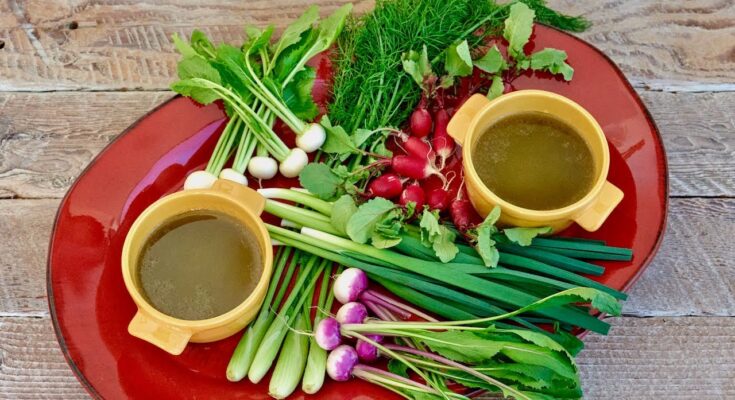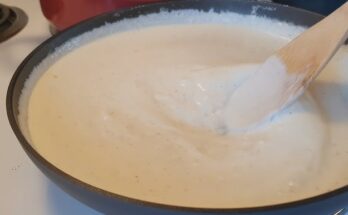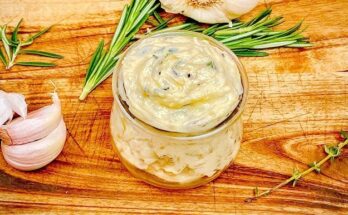Bagna Cauda Recipe: If you’ve never heard of Bagna Cauda, buckle up—you’re about to fall in love with one of Italy’s most comforting, social, and flavorful dishes. Pronounced bahn-yah cow-dah, this warm dip is a mouthwatering blend of garlic, anchovies, olive oil, and butter. Traditionally served in a communal pot with a medley of fresh vegetables, it’s the ultimate dish for dipping, sharing, and gathering.
Think of Bagna Cauda as the Italian answer to fondue, only bolder and packed with umami. It’s not just a recipe; it’s a whole experience. You dip your veggies (and sometimes even crusty bread) into this savory, aromatic bath of goodness, savoring every bite like it’s your last meal on Earth. Sounds tempting, right?
What makes Bagna Cauda so irresistible is its simplicity. Just a handful of ingredients, slowly simmered until silky, results in a sauce so rich it could convert even the most stubborn garlic skeptics. But don’t worry—we’re breaking it all down for you, step by step. Whether you’re cooking for a cozy date night or planning a big family feast, Bagna Cauda is here to impress.
The History and Origin of Bagna Cauda
Bagna Cauda hails from the Piedmont region of Northern Italy, a place famous for truffles, wines, and heartwarming rustic dishes. The name itself literally translates to “hot bath” in Italian—which makes sense when you see this dish bubbling in a ceramic pot, begging to be dipped into.
Originally, Bagna Cauda was considered peasant food, a practical way to turn humble ingredients into something truly indulgent. Farmers would gather after harvest, heat a pot over an open flame, and share this dip with the produce they had grown. It became a symbol of community, warmth, and sharing—values that remain embedded in the dish today.
Over time, Bagna Cauda gained popularity beyond Piedmont and evolved from a simple rustic meal into a culinary gem enjoyed across Italy and beyond. While the core ingredients remain the same, modern chefs and home cooks have started to add their own twists. From using cream for a silkier texture to serving it with seafood, Bagna Cauda now comes in many delicious forms.
But at its heart, Bagna Cauda is still all about bringing people together over a shared pot of flavor-packed warmth. It’s not just food; it’s tradition served hot.
Why Bagna Cauda is a Must-Try Italian Classic
What makes Bagna Cauda stand out in a sea of Italian recipes? It’s not your usual pasta or pizza—it’s something unique, deeply flavorful, and centered around the act of dipping and sharing. It’s warm, rich, and slightly briny thanks to the anchovies, balanced beautifully by the mellowed garlic and buttery finish.
This dish delivers a sensory punch. The aroma alone will pull everyone to the table. The texture? Silky and luxurious. The taste? Think of it as the Italian version of umami heaven. And the best part? It’s completely customizable. Love it garlicky? Load it up. Prefer it creamier? Add more butter or even a splash of cream.
Whether you’re planning a holiday gathering or simply want to spice up your dinner routine, Bagna Cauda is the dish that says, “Let’s slow down, dip, and enjoy.”
Traditional vs. Modern Bagna Cauda Variations
Traditionally, Bagna Cauda includes garlic, anchovies, olive oil, and butter—that’s it. Some purists will argue against adding anything else, claiming it compromises the soul of the dish. But like any recipe passed down through generations, Bagna Cauda has evolved.
Modern variations often include:
- Cream or milk to soften the garlic’s sharpness
- White wine for a subtle tang
- Chopped nuts for texture
- Herbs like parsley or rosemary for aroma
Some folks even turn Bagna Cauda into a pasta sauce or use it as a base for grilled meats. And yes, there are vegan versions made with miso paste instead of anchovies. No matter which route you take, the essence remains the same—a warm, flavorful dip that encourages sharing.
Health Benefits of the Main Ingredients
At first glance, Bagna Cauda might seem like an indulgence—and it is—but its core ingredients are surprisingly healthy when consumed in moderation.
Garlic is a powerhouse. It’s loaded with antioxidants, helps reduce blood pressure, and boosts the immune system. When slow-cooked, garlic becomes mellow and sweet while keeping many of its health benefits intact.
Anchovies, though small, pack a punch. They’re full of omega-3 fatty acids, which support heart and brain health. They’re also rich in calcium and protein.
Olive oil, a staple of the Mediterranean diet, is known for its heart-healthy fats and anti-inflammatory properties.
Butter, while richer, adds creaminess and depth. In moderation, it’s a fine addition—especially when balanced by the olive oil.
So while Bagna Cauda might feel indulgent, it’s also nourishing—both for the body and the soul.
List of Ingredients You’ll Need
Essential Ingredients
Here’s what you absolutely need to make a classic Bagna Cauda:
- 10 cloves garlic (peeled)
- 10–12 anchovy fillets in oil (drained)
- 1 cup extra virgin olive oil
- 4 tablespoons unsalted butter
Optional Add-ons
- ¼ cup heavy cream (for a smoother texture)
- Pinch of crushed red pepper flakes (for heat)
- 1 tablespoon white wine (for depth)
- Finely chopped parsley (for garnish)
Best Vegetables for Dipping
Want to get the full experience? Pair your Bagna Cauda with a colorful assortment of these:
- Raw fennel
- Bell peppers
- Carrot sticks
- Blanched cauliflower
- Steamed potatoes
- Celery
- Cherry tomatoes
- Endive leaves
- Roasted mushrooms
- Fresh radishes
Pro Tip: Always have some crusty bread on the side to soak up every last drop.
Kitchen Tools Required
Before diving in, make sure you’ve got these tools ready:
- Small saucepan or fondue pot
- Wooden spoon or silicone spatula
- Cutting board
- Chef’s knife
- Small whisk (optional)
- Serving bowl or communal pot
Prepping the Ingredients
How to Properly Peel Garlic
Garlic is the star here, so prep it with love. Start by smashing each clove with the flat side of a knife to loosen the skin. Then peel it clean. If you’re sensitive to garlic’s strong flavor, you can blanch it (more on that next) to mellow it out.
Cleaning and Prepping Anchovies
Use anchovies packed in olive oil—they’re softer and more flavorful. Drain them well, and if you’re squeamish about the strong smell or taste, give them a light rinse under cold water and pat them dry. Chop them roughly before cooking.
Step-by-Step Guide to Making Bagna Cauda
Alright, time to get your apron on and bring some rustic Italian magic into your kitchen. Making Bagna Cauda is not complicated, but it does require patience and low heat. The slower you go, the better the flavors meld together. Here’s how to make it from scratch:
Step 1: Blanching the Garlic
Start by peeling several cloves of garlic and blanching them in boiling water for about 2 minutes. Drain and repeat this process two or three times with fresh water. This step softens the garlic’s sharp bite, leaving it mellow and sweet without losing its signature aroma.
Step 2: Slow Cooking the Garlic and Anchovies
In a small heavy-bottomed pan, add the blanched garlic and anchovy fillets. Pour in a bit of olive oil and cook slowly over low heat. Stir occasionally until the garlic becomes creamy and the anchovies melt into a smooth, savory paste.
Step 3: Adding Olive Oil and Butter
Gradually whisk in more olive oil and a few tablespoons of butter. Continue cooking gently until the mixture turns silky and aromatic — this forms the luscious base of the Bagna Cauda.
Step 4: Final Touches and Serving Warm
Keep the sauce warm but not boiling. Transfer it to a small fondue pot or heatproof bowl. Serve immediately with an assortment of crisp vegetables like carrots, celery, and bell peppers for dipping — a rustic, cozy Italian delight.
Serving Suggestions
So you’ve got your Bagna Cauda ready, hot and fragrant. Now what? Let’s talk about the best ways to enjoy it.
What to Dip in Bagna Cauda
You can dip pretty much anything, but here are some top picks:
- Crunchy carrots and celery: A classic combo that balances the richness of the sauce.
- Blanched cauliflower and broccoli: Adds texture and soaks up flavor like a sponge.
- Sweet bell peppers: Raw or lightly roasted, they bring color and sweetness.
- Steamed potatoes: Tiny fingerlings or baby reds are perfect.
- Radishes: For a peppery crunch.
- Crusty bread: Ideal for mopping up the last drops.
What to Serve It With
Pair it with a light Italian red wine like Dolcetto or Barbera. Want to go all out? Add:
- A charcuterie board
- Marinated olives
- A simple arugula salad
Or serve Bagna Cauda as a starter to a larger Italian meal. Trust us—people will talk about this dip long after dinner’s done.
Bagna Cauda as a Party Dish
Bagna Cauda is not just food—it’s a whole vibe. It’s social, shareable, and deeply satisfying, making it the ultimate party starter. Hosting a gathering? Here’s how to turn this dish into the main attraction:
- Use a fondue pot or small chafing dish to keep it warm throughout the night.
- Set up a DIY dipping station with a rainbow of veggies, crusty bread, and small plates.
- Offer a vegan version on the side to make it inclusive.
- Create individual servings in ramekins if you want a more formal touch.
Want to take it even further? Theme your party around Northern Italy and serve with Barolo wine, antipasti, and a playlist of Italian classics.
Vegan or Vegetarian Alternatives
While anchovies are key to traditional Bagna Cauda, you can still enjoy a meat-free version that captures the same savory depth.
Vegan Version:
- Replace anchovies with white miso paste (2–3 tablespoons).
- Use plant-based butter and olive oil.
- Add a dash of soy sauce or liquid aminos for umami.
- Blend for a creamy consistency.
Vegetarian Version:
- Skip the anchovies and use capers or olives for a salty kick.
- You could also mix in some parmesan cheese for richness.
These alternatives aren’t exactly the same, but they’re pretty darn close—and delicious in their own right.
Common Mistakes to Avoid
Bagna Cauda may seem simple, but a few wrong moves can mess it up. Here’s what to watch out for:
- Overheating the oil: This will burn the garlic and anchovies, turning the dip bitter.
- Not blanching the garlic: Raw garlic can overpower the whole dish.
- Using low-quality olive oil: This is a flavor-forward recipe—don’t cheap out.
- Skipping the anchovy prep: Rinse or soak them briefly to avoid a fishy taste.
- Serving it cold: This dip must stay warm to keep its luscious texture.
Get these basics right, and you’ll have a Bagna Cauda that’s worthy of an Italian grandmother’s approval.
Storing and Reheating Tips
Got leftovers? Lucky you. Here’s how to store and reheat like a pro:
- Storing: Let the Bagna Cauda cool completely, then store in an airtight container in the fridge for up to 4 days.
- Reheating: Warm slowly in a saucepan over low heat, stirring constantly. You can add a splash of olive oil or cream to loosen it up if it thickens.
- Freezing: Not recommended—the texture can get weird after thawing.
Pro tip: Use leftovers as a pasta sauce or drizzle over grilled veggies the next day.
FAQs about Bagna Cauda Recipe
1. Can I make Bagna Cauda ahead of time?
Yes! Just prepare it, store in the fridge, and gently reheat before serving. It tastes even better the next day.
2. What can I substitute for anchovies if I don’t eat fish?
Try white miso paste or capers for a similar salty, umami flavor.
3. Is Bagna Cauda gluten-free?
Absolutely! Just make sure you serve it with gluten-free bread or veggies.
4. Can I use garlic paste instead of fresh garlic?
Fresh garlic is recommended for best flavor, but in a pinch, a high-quality garlic paste can work—just reduce the quantity.
5. What wine pairs well with Bagna Cauda?
Go for a light, crisp white like Pinot Grigio or a low-tannin red like Dolcetto.
Conclusion
Bagna Cauda is more than just a dip—it’s an experience, a tradition, and a guaranteed crowd-pleaser. Whether you’re recreating a cozy Italian evening at home or adding something unique to your holiday spread, this warm, garlicky bath of goodness never fails to impress.
It’s humble yet elegant, simple yet bold, and perfect for sharing with the people you love. So the next time you want to bring some heart and soul to the table, fire up a pot of Bagna Cauda. You’ll never look at garlic and anchovies the same way again.



